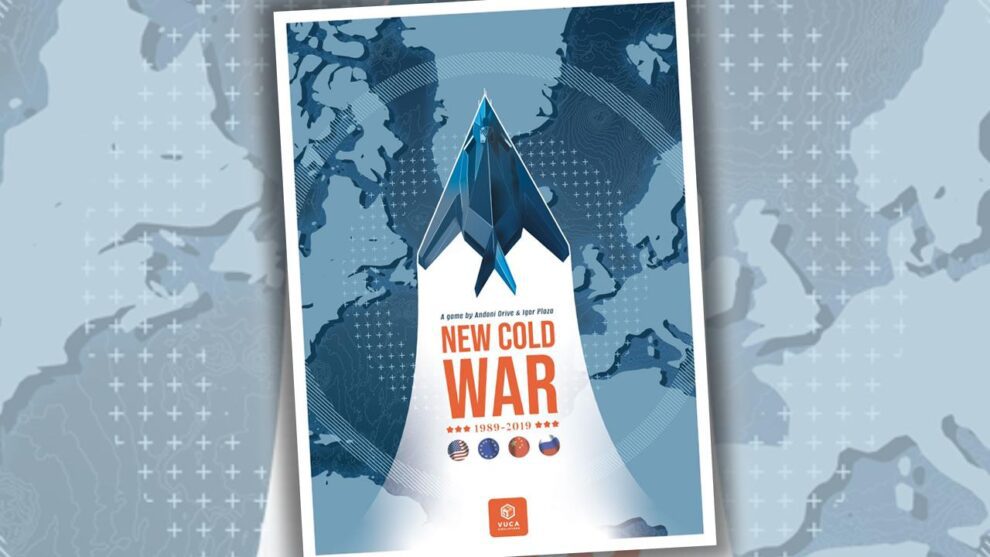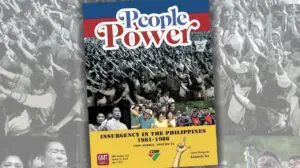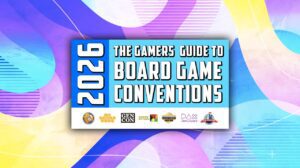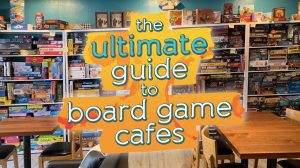Disclosure: Meeple Mountain received a free copy of this product in exchange for an honest, unbiased review. This review is not intended to be an endorsement.
From January 2011 to December 2015–five full years–Twilight Struggle held the #1 spot on Board Game Geek’s Top 100 games of all time. An impressive accomplishment, especially for a war game. There have been plenty of games since its release that have borrowed elements from its card-driven gameplay and area-majority scoring, attempting to capture the same magic that pushed it to the top of that list. New Cold War from VUCA Simulations is one such game that wears its influence on its sleeve and doesn’t hide the fact that it wants to be Twilight Struggle for 4 players.
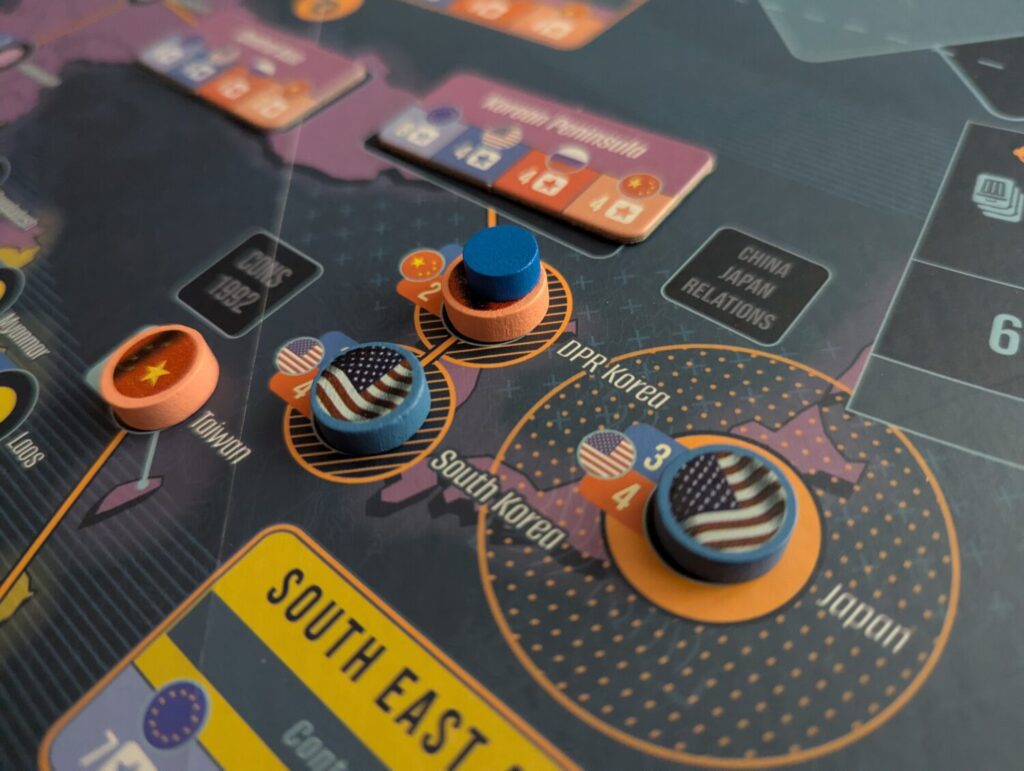
They Didn’t Start the Fire
Covering the 30 years between the collapse of the Soviet Union and the COVID-19 pandemic, players take the roles of the US, Russia, China and the European Union, spreading their influence to control the globe or, as is the case here, either completing two objectives for an automatic win or having the most victory points. Players will use cards in their hand either for its event or operation points (OPs) in an attempt to control countries and score regions around the world. If you’ve ever played Twilight Struggle, you’re most of the way there.
The twist in New Cold War is that the US and Russia players are allied with the EU and China players, respectively. This is where the game stands apart from its biggest influence. At the beginning of 6 of the 9 turns, you will exchange a card in your hand. You will share bonuses tied to media coverage of your bloc, and you will stabilize or destabilize countries to the advantage of both powers in the alliance. In the end, there is only one winner, but you will rely heavily on your partner to achieve many of your goals.

Ally or Sidekick
For the most part, I really enjoyed this cooperative element of the game. Some of the best moments were strategizing, both openly and covertly, about how my partner and I would simultaneously split up the world while also keeping the enemy bloc at bay or overcoming a rough event. Be warned, though, not everything is equal in these partnerships.
From the start of the game, only the US and Russia have the entire map of the world to play in, placing their control markers wherever they like. The EU begins with access to Europe and Africa, and China has only a quarter of the map in Asia and Southeast Asia. They will have to wait until turn 5 (of 9 in the game) to access other areas. Some events allow them to gain access earlier, though China can never go into Europe. While this can give these players a strong foothold in these starting areas, it’s also severely limiting compared to the US and Russia, especially when it comes to meeting objectives, which are tied to control of areas across the board.
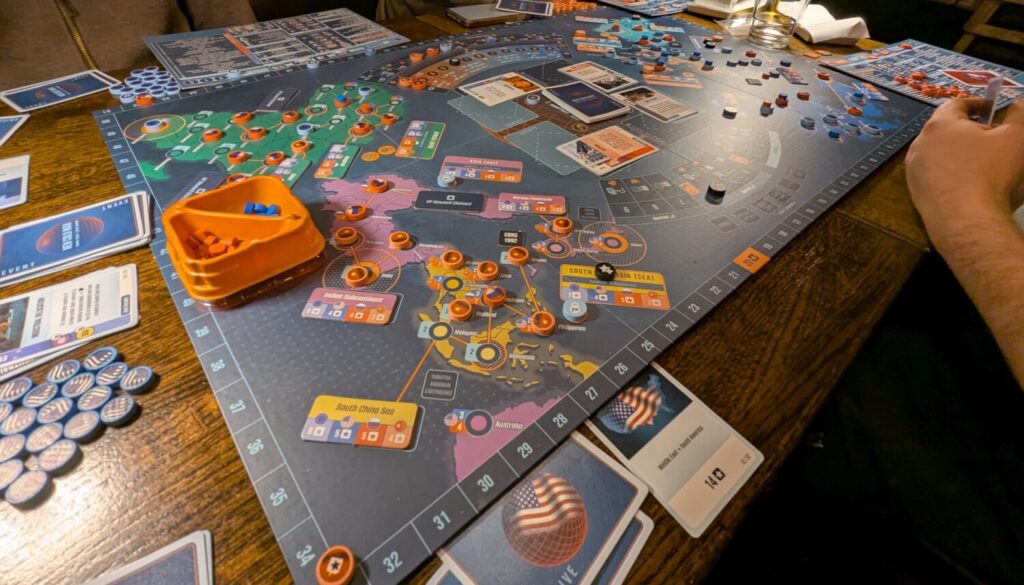
This map’s inaccessibility is not the only imbalance between the powers. All players have 3 to use for the entire game, but the US and Russia have an extra Veto marker they can use in the first 3 turns. These are used to stop an action or event on a played card from an opponent, including the event that allows early access to the locked areas for the EU and China. [Spoiler: a veto was used for precisely this in all my playthroughs] China and EU can feel like playing second fiddle, being taken advantage of by their more powerful counterparts.
Sharing is Caring
One of the best aspects of New Cold War is how OPs are spent both individually and as part of a bloc. Similar to other card-driven war games, each card either has one of the four power flags on it to indicate which power is affected by the event on it or it is a neutral card whose event is not tied to a particular power. If you play your own power’s card, you must choose either to use it for the event or the OPs but if it is an opponent’s card (including allies) then the event will always trigger, even if you play it for its OPs. Getting your own cards into the hand of your ally is almost always win-win because they get to use the OPs to benefit themselves while still ensuring your event happens. As tends to happen in these games, however, you will many times be stuck with a handful of opponent cards and no good options, so using the OPs becomes crucial.
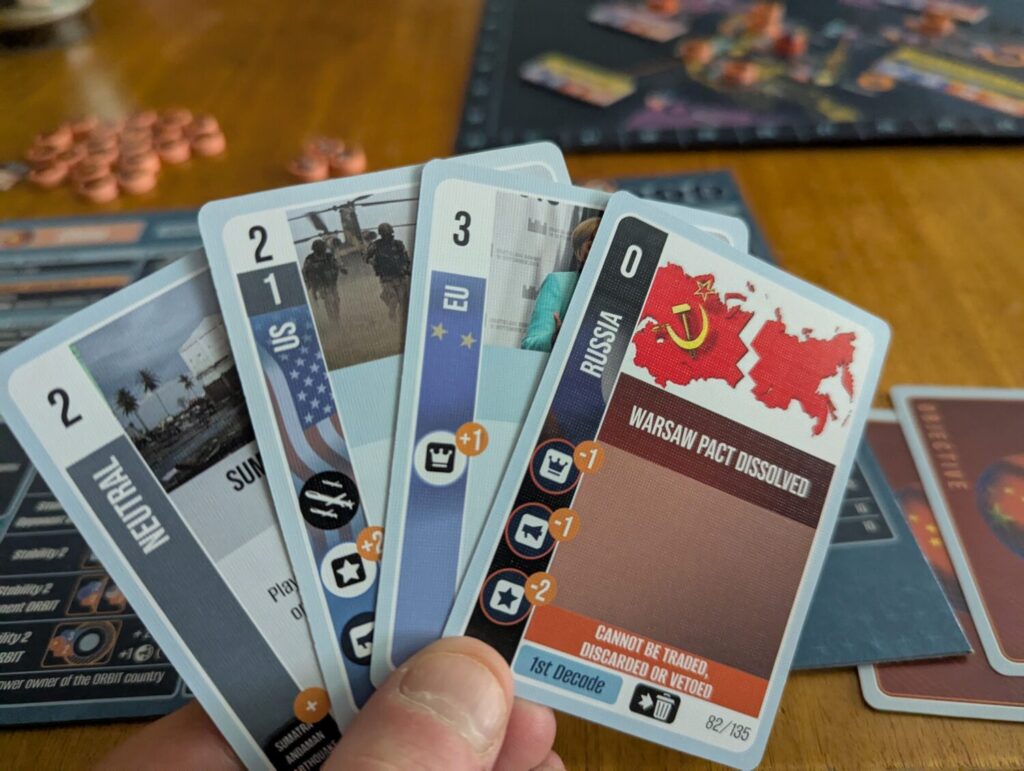
In addition to using OPs for removing or gaining control of a country, there’s also the Media and Prestige tracks, which are basically areas to use OPs that can benefit an individual or bloc to reward bonuses and, in the case of the Media Track, team up with your ally, spending 1 OP each to bump up a spot on the track. This is a tug-of-war track between the two blocs, however, so only one side will benefit when it is checked before Prestige and Scoring phases. The Prestige Track ranks each power and gives out rewards or punishments at certain points, depending on your location. It is also the most affected by the negative (black) cards that each power has in a deck. These negative events cannot be vetoed, traded, or discarded, so they will occur every time they are dealt out. Protecting yourself from these events by spending OPs to move up in prestige was one of the more original, strategic features in the game.
You May Ask Yourself “How Did I Get Here?”
Like many war games, the biggest hurdle for new players will be some of the rules and iconography on the board and cards. This is where a solid rulebook becomes crucial. Like all the physical elements of the game, New Cold War has a slick, modern, and meticulously detailed design to its rulebook. Unfortunately, it is so concerned with covering every possible example that might come up, that it misses the forest for the trees.
Right off the bat, there is no photo of the full map anywhere to help with setup, only close-ups of individual areas. There is an appendix which shows all of the symbology on the cards, but for explanations you have to go to specific areas spread out in the rulebook. It took us a while to even understand what the flag icon meant because it was never explained properly.
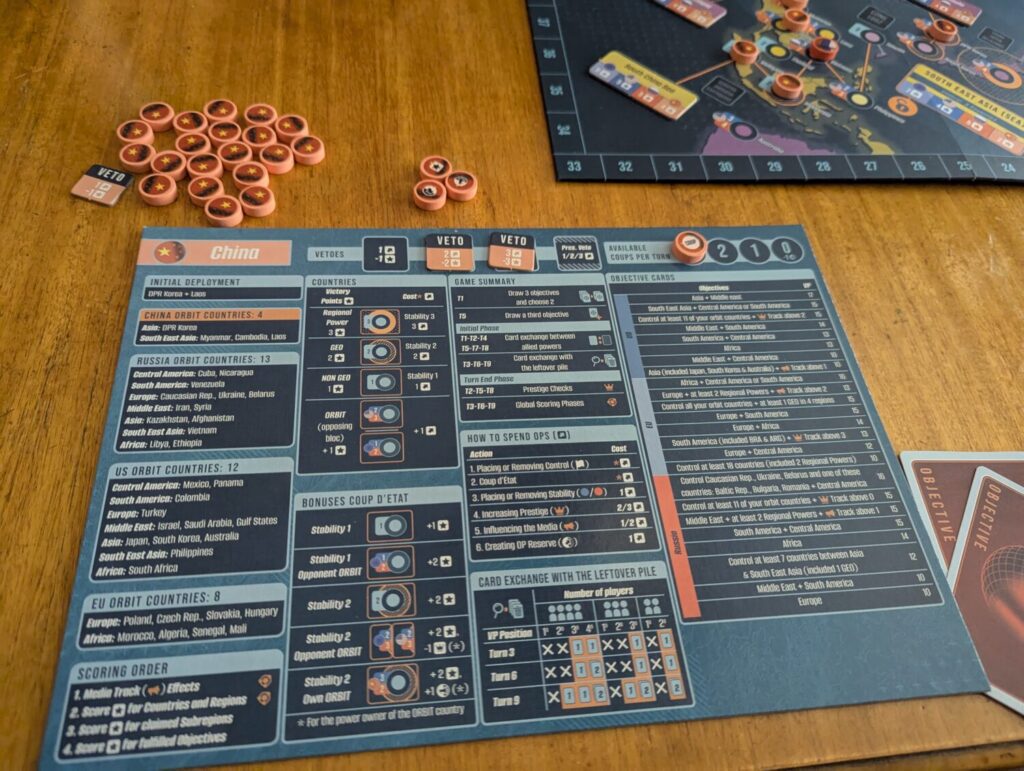
The individual player boards act as a player aid and are slightly more helpful, but there are so many fiddly rules as it pertains to coups, control, and cards or map areas with different numbers printed on them, that keeping track of them was a real chore and slowed down each game. Even after several plays, when I thought I had a good grasp of the rules, I was still checking the rulebook to confirm some of the information, and finding the exact section where a specific rule was located was an exercise in frustration. Teaching it to new players became much more tedious.
Don’t Say We Didn’t Warn you
“American Exceptionalism” is alive and well in New Cold War. In all of my playthroughs, the US player won every game–and most times by quite a lot. This is not a design flaw but, rather, built intentionally into the game. In the final ‘How to Win’ section of the rulebook (5.3. US Superiority), it lays it out plainly. Unless everyone else works together to take them down, “the US player is more likely to win on a greater number of occasions”. In theory, I appreciate that historical accuracy is important and, coming from a publisher with “Simulations” in their name, this was not entirely unexpected. In practice, though, that huge advantage that the US player has (especially early on) can make the game feel like a hopeless, uphill battle for all the other players.

It got fairly comical after a while. For my final playthrough, I intentionally tabled it with 2 other players who had a lot of experience with both heavyweight war games and Twilight Struggle, and a third, assigned as the US player, who had experience with neither. She still won by 21 pts, which is quite a lot in this game.
Many other historical war games contain this type of asymmetry that aims to drive home the real-life circumstances of the period but, generally, there is also a way to offset those imbalances in service of gameplay, such as the COIN series having variable winning conditions for each faction. There are no real chances for big swings to catch up to your rivals either, such as coups and realignments in Twilight Struggle. Other than accomplishing the 2 objectives for an automatic victory, which is also available to the US player, there is no such counter in New Cold War, or even rules for a variable setup that could level the playing field slightly.
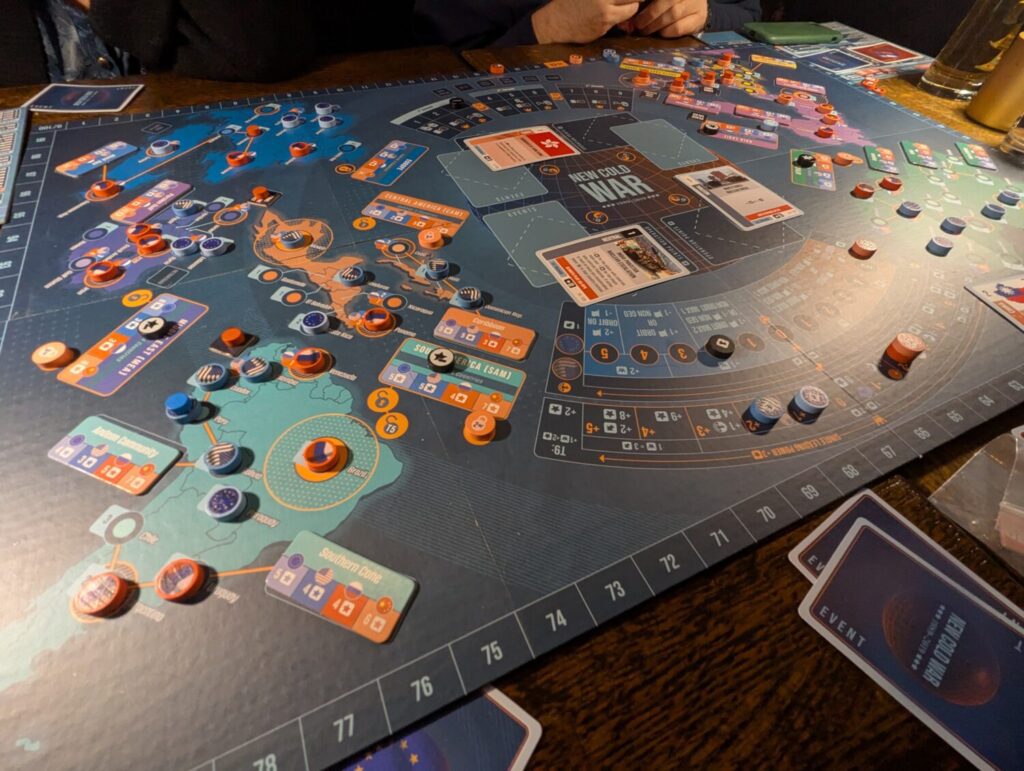
All in All, it’s just Another Game on the Shelf
Though my issues with New Cold War didn’t keep me from enjoying each of my plays, there was just something unsatisfying about how each game ended. It felt less like a strategic battle between 4 powers and more like a game of “catch up to the US”. Maybe that is the point of a simulation-style game, but my excitement for the game when it arrived fell sharply as players found themselves stuck in the rulebook, trying to remember how stability worked or exactly how many OPs it actually took to coup an ORBIT country, or whether it could be done at all.
I would still play this game at 4 players. There’s enough in the team interaction and the event cards that I want to explore again. Solo players may also find it an appealing challenge, though the bots-only workflow section is as lengthy as the one for the standard rules. I don’t see the point in playing a two vs one-and-a-bot at 3 players, simply for time’s sake, and at 2 players, you might as well just break out Twilight Struggle for a cleaner, tighter experience. New Cold War had its highlights but, ultimately, was an exercise in patience.


